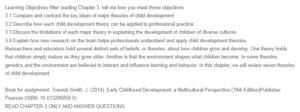Learning Objectives – Child Development Theory
Objective 1: Compare and Contrast Key Ideas of Major Theories of Child Development
By knowing different theories of child development, I will be able to understand how children develop and learn. According to Trawick-Smith (2014), knowledge about child development theories is crucial for any instructor aiming to work with varied types of learners and, therefore, guides them into working with children to meet their physical, emotional, cognitive, and social needs. Every theory has its own set of beliefs and assumptions. Therefore, by understanding the similarities and differences, I will apply the knowledge to predict future behavior and, thus, apply the right teaching methods.
Objective 2: Describe How Each Child Development Theory Can Be Applied to Professional Practice
Early childhood education theories empower teachers with the framework that should guide their teaching practices (Trawick-Smith,2014). By knowing these theories, I can decide which teaching methods I should apply in different environments. Additionally, knowledge about child development theories will empower me to intentionally plan and design a curriculum that suits the needs of my learners.
Objective 3: Describe the Limitations of Each Theory in Explaining the Development of Children of Diverse Cultures.
Children are born different, and therefore, they do not necessarily learn at the same pace as Piaget’s child development theory suggests. By understanding this limitation, I can handle children differently because they come to the classroom with varied needs. Another limitation of Piaget’s theory is that it needs more appropriate flexibility for students with different learning abilities since it has stages with specific ages assigned (Trawick-Smith, 2014). This theory does not take into consideration the needs of children born with special needs and how they should be treated with the utmost care. Therefore, by understanding this limitation, I can align my teaching strategies based on the type of learners I have and their individual needs. Another theory with possible limitations is the Social Learning Theory. The theory disregards biological factors such as hormones and genetics influencing children’s behavior. By having this knowledge, I will be able to understand that a child’s behavior may result from environmental or biological factors.
Objective 4: Explain How New Research on the Brain Helps Professionals Understand and Apply Child Development Theories
Understanding how the brain works or functions can help teachers evaluate the developmental stages of their learners based on children’s levels of physical, mental, social and cognitive development. This knowledge will guide me as a teacher to select the instruction that aligns with the maturity levels of the learner. I will also be able to understand the importance of giving children proper care from birth to adulthood. Additionally, I will be able to understand what differentiates a child who has achieved maximum brain development from those with possible learning difficulties.
References
Trawick-Smith, J. W. (2014). Early childhood development: A multicultural perspective (7th ed.). Pearson.
ORDER A PLAGIARISM-FREE PAPER HERE
We’ll write everything from scratch
Question

Learning Objectives – Child Development Theory
Learning Objectives
After reading Chapter 3, tell me how you meet these objectives
3.1 Compare and contrast the key ideas of major theories of child development.
3.2 Describe how each child development theory can be applied to professional practice.
3.3 Discuss the limitations of each major theory in explaining the development of children of diverse cultures.
3.4 Explain how new research on the brain helps professionals understand and apply child development theories.
Researchers and educators hold several distinct sets of beliefs, or theories, about how children grow and develop. One theory holds that children simply mature as they grow older. Another is that the environment shapes what children become. In some theories, genetics and the environment are believed to interact and influence learning and behavior. In this chapter, we will review seven theories of child development.
Book for assignment: Trawick-Smith, J. (2014). Early Childhood Development: a Multicultural Perspective (7thh Edition)Publisher: Pearson (ISBN: 10 013286859 8)
READ CHAPTER 3 ONLY AND ANSWER QUESTIONS

